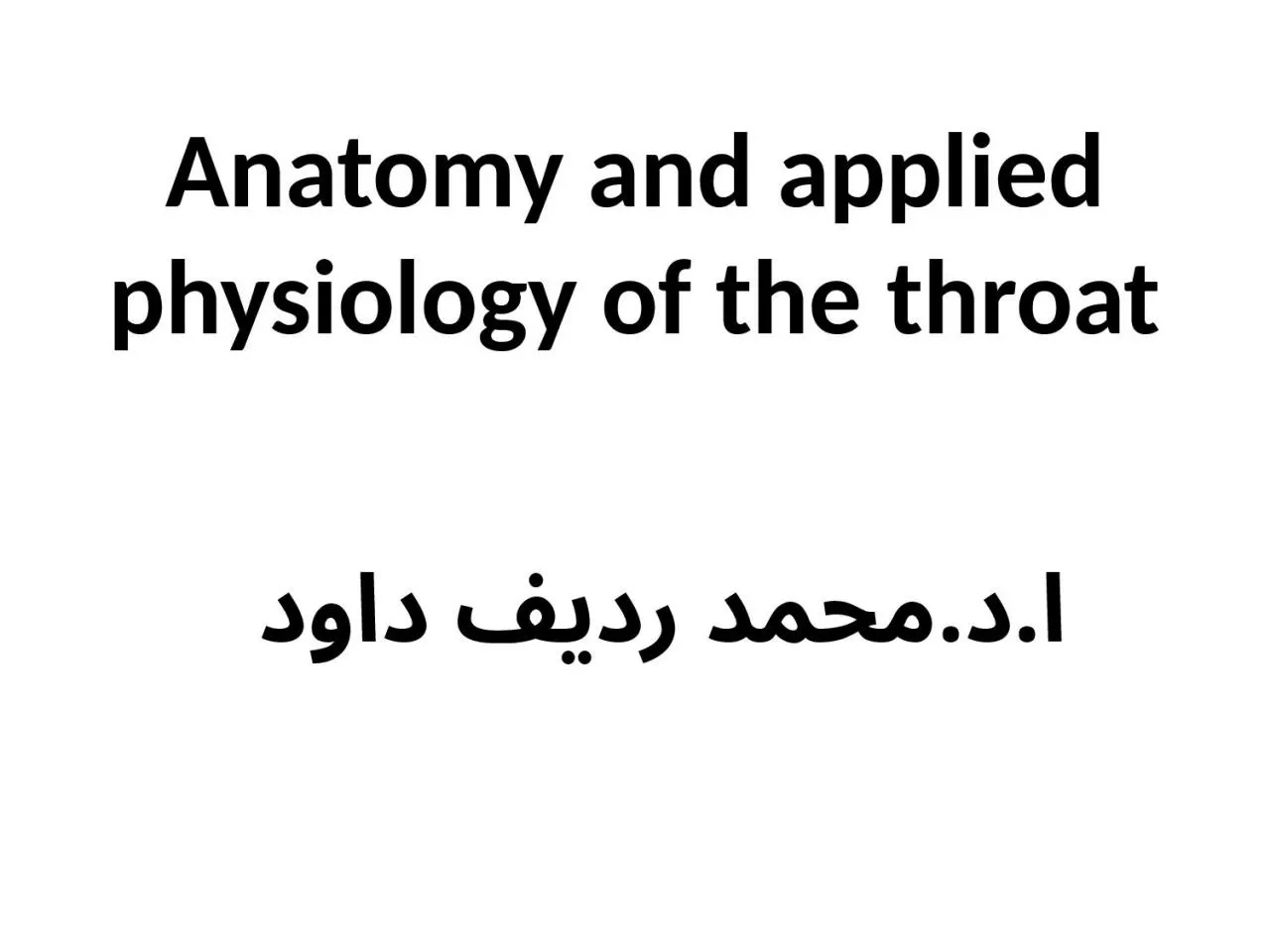

ا دمحمد رديف داود Mouth The is also known as the oral cavity It has three major functions Digestion receives food transfer it the pharynx to preparing ID: 932535
Download Presentation The PPT/PDF document "Anatomy and applied physiology of the th..." is the property of its rightful owner. Permission is granted to download and print the materials on this web site for personal, non-commercial use only, and to display it on your personal computer provided you do not modify the materials and that you retain all copyright notices contained in the materials. By downloading content from our website, you accept the terms of this agreement.
Slide1
Anatomy and applied physiology of the throat
ا
.د.محمد
رديف داود
Slide2Mouth
The
is
also known as
the
oral
cavity
.
It has three major functions:
Digestion
– receives food,
transfer it
the pharynx to preparing
it for digestion in the stomach and small intestine.
Communication
– modifies the sound produced in the larynx to create a range of sounds.
Breathing
– acts as an air inlet in addition to the nasal cavity.
Slide3Anatomy
The
oral cavity
lies between the oral fissure (anteriorly – the opening between the lips), and the
oropharyngeal
isthmus (posteriorly – the opening of the oropharynx
).
The two divisions of the oral cavity are the vestibule, and the mouth cavity proper
Vestibule
It is the space between the lips/cheeks, and the gums/teeth
Mouth proper
The mouth proper lies posteriorly to the vestibule, the tongue fills a large proportion of the cavity of the mouth proper
.
The
roof
of the mouth proper consists of the hard and soft palates
.
The
floor
of the oral cavity consists of several structures
:
Muscular diaphragm – comprised of the bilateral
mylohyoid
muscles,
geniohyoid
muscles, sublingual salivary glands and ducts
Slide4Pharynx
It
begins at the base of the skull, and ends at the inferior border of the cricoid cartilage (C6). The pharynx is comprised of three parts (superior to inferior):
1.
Nasopharynx
2. Oropharynx
3. Laryngopharynx
Slide5Nasopharynx
It
is found between
the base of the skull and the soft palate.
It is continuous with the nasal cavity, and performs a respiratory
function by conditioning inspired air and propagating it into the larynx
.
The
posterosuperior
wall of
nasopharynx
contains the
adenoid tonsil
,
which enlarge between 3-8 years of age and then regress.
Slide6Oropharynx
It
is the middle part of the pharynx, located between
the soft palate and the superior border of the epiglottis.
It
contains the following structures:
1
. Posterior
1/3 of the tongue.
2
. Lingual
tonsils – lymphoid tissue at the base of the tongue.
3
. Palatine
tonsils – lymphoid tissue located in the
tonsillar
fossa (between the
palatoglossal
and
palatopharyngeal
4. Superior
constrictor
muscle.
Waldeyer’s
ring
is the ring of lymphoid tissue in the
naso
- and oropharynx formed by the
paired palatine tonsils, the adenoid
tonsil,
lingual
tonsil and scattered lymph nodes
.
The oropharynx is involved in the
voluntary and involuntary phases of swallowing
Slide7Laryngopharynx
The most distal part of the pharynx, located
between the superior border of
the epiglottis and inferior border of the cricoid cartilage
(C6). It is continuous inferiorly with the
oesophagus
.
It is found posterior to the larynx and communicates with it via the laryngeal inlet, lateral to which one can find the
piriform
fossae.
The laryngopharynx contains th
e middle and inferior pharyngeal constrictors
Slide8Muscles of pharynx
There are two main groups of pharyngeal muscles
;
Circular
1. Superior
pharyngeal constrictor
2. Middle pharyngeal constrictor
.
3.Inferior
pharyngeal constrictor
All pharyngeal constrictors muscles are innervated by the
vagus
nerve
(CN X)
longitudinal muscles
1.
Stylopharyngeus
it
is innervated by the glossopharyngeal nerve
2.
Palatopharyngeus
Innervated
by the
vagus
nerve
3.
Salpingopharyngeus
Innervated
by the
vagus
nerve
Slide9Blood supply of the pharynx
Arterial
supply
to the pharynx is via branches of the
external carotid
artery:
1. Ascending
pharyngeal artery
2. Branches
of the facial artery
3. Branches
of the lingual and maxillary arteries.
Venous
drainage
is achieved by the
pharyngeal venous plexus
, which drains into the internal jugular vein
Slide10larynx
The
cartilaginous framework
A.
Unpaired cartilages
1. Epiglottis
2.The
cricoid cartilage
B.
Paired cartilages
1. The arytenoids cartilages
2. The thyroid cartilages
Slide11Intrinsic muscles
1
. Muscle that open the vocal cords
Posterior
cricoarytenoid
muscle
2
. Muscles that close the vocal cords
A-Lateral
cricoarytenoid
muscle
B-
Interarytenoid
musle
C-
Cricothyroid
muscle
3
. Muscle that increase the tension of the vocal cords
Thyroarytenoid
(
vocalis
) muscle
Slide12Arterial blood supply
1. Superior
Laryngeal artery: branch of superior thyroid artery
2. Inferior
Laryngeal artery: branch of inferior thyroid artery
3.
Cricothyroid
artery: branch of superior thyroid artery
Slide13Innervations
Motor innervations
by the recurrent laryngeal nerve that supplies all the intrinsic muscles of the larynx
except
the
cricothyroid
muscle which is supplied by the external laryngeal nerve which is branch of superior laryngeal nerve
Sensory innervations
of the larynx for the area
above
the vocal cords is supplied by the internal laryngeal branch of superior laryngeal nerve while the area
below
the vocal cords is supplied by the recurrent laryngeal nerve.
Slide14Functions of the larynx
1. Respiration
.
2. Phonation
(voice).
3. Protection
of lower airways.
4. Fixation
of chest
Slide15THANK YOU